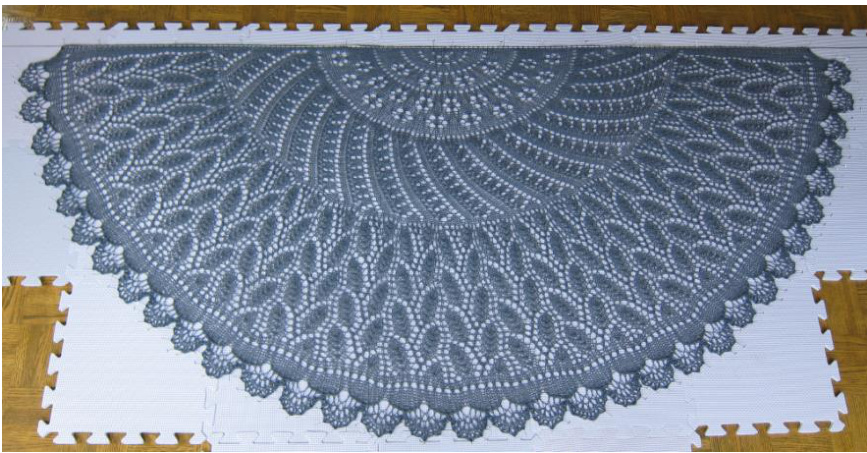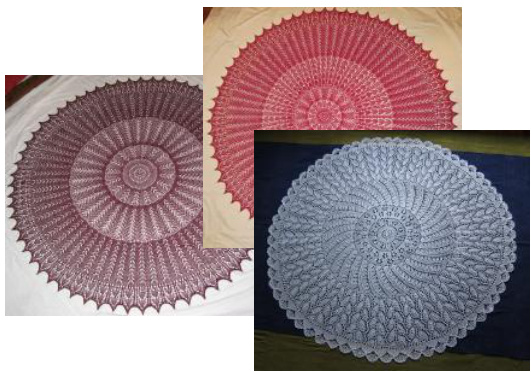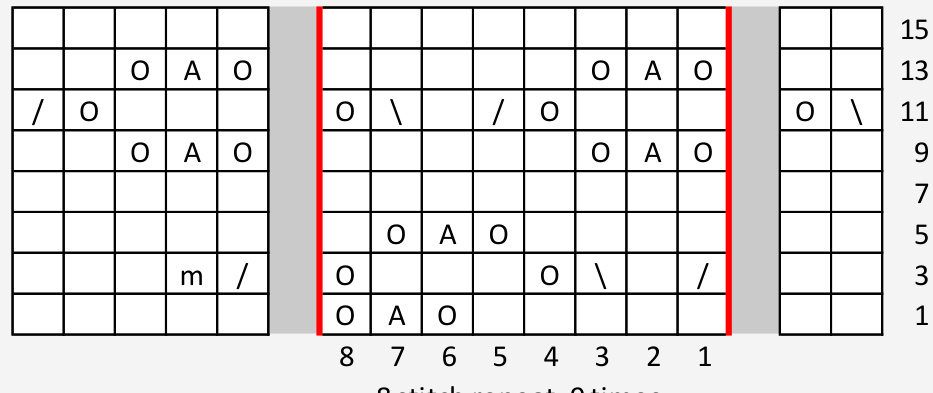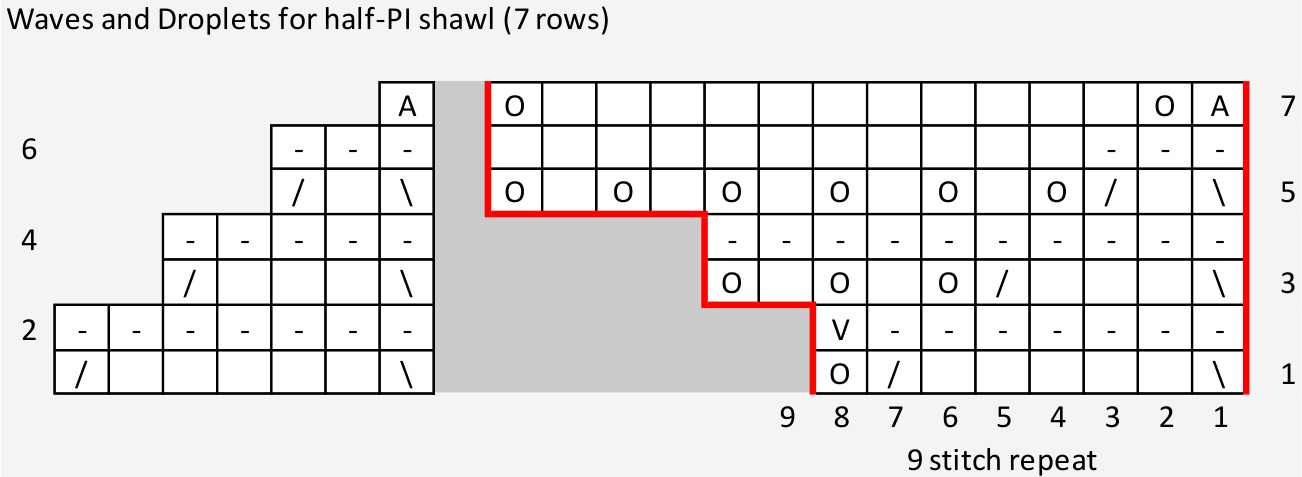: 100th Anniversary PI Shawl: Camping (half circle versiol
Elizabeth Zimmermann was born on August 9th, 1910 (8/9/10). This shawl is the half-circle version of the Camping shawl, one of a set of three Pl shawls designed as a tribute to EZ and a celebration of all she has done for us. For the EZ 100th Anniversary Pl Shawls, modifications were applied so that the stitch pattern repeats are multiples of 8, 9, and 10 (the numbers in EZ's birthday). For

the half-circle version of the shawl, the same stitch patterns are used with modifications so that they can be knit back and forth, purling back on wrong side rows. A garter stitch border is incorporated. The theme of the camping shawl is the wonderful camping trips that EZ describes. In the "Knitter's Almanac" (page 85), she describes being over 60, water-camping and fishing in the Canadian north woods. Spectacular! There are other stories about camping by the Mississippi, "dandled by the milky ripples" of the river (The Opinionated Knitter, page 70). But my absolute favourite is about a camping trip on a remote island in northern Canada, in late September 1971, with Elizabeth, the Old Man, and KLINE the cat (The Opinionated Knitter, pages 38-41). If you have never read this, you simply must get hold of it. Camping with EZ: The Paw Prints in the centre of the shawl honour KLiNE and all our furry companions. The Slanting Twigs in the next ring represent a walk in the forest with sun shining through the trees. The Willow Leaves in the outer ring celebrate the beauty of everything growing and green. The Waves and Droplets edging represents water lapping at the edge of the lake or river, and rolling back across the sand and rocks. The first three stitch patterns are from "The Haapsalu Shawl, A Knitted Lace Tradition from Estonia", and the fourth stitch pattern is Judy Gibson's scalloped edging (http://tiajudy.com/scallopedge.htm). The instructions in this document will produce a half-circle version of the Camping shawl. I used 5mm needles and approximately 770 yards of fingering weight yarn. Your experience may vary depending on yarn weight, needle size, and tension. Use any yarn weight and needle size that you like. You don't have to use the stitch patterns provided here, you could unvent your own! Include any pattern that has stitch repeats of 8, 9, or 10. The three full circle Pl shawls can be found on Ravelry, and each one has a half-circle alternative design: EZ 100th Anniversary PI Shawl: Gull Wings EZ 100th Anniversary PI Shawl: Hearts EZ 100th Anniversary PI Shawl: Camping Symbols: Rs: Right side, Ws: Wrong side, k: knit; p: purl; yo: yarn over; k2tog: knit 2 together; ssk: slip 2 stitches knitwise one at a time, slip left needle into the front of both stitches from the left and knit them together from that position OR slip 1, knit 1, psso (pass slipped stitch over); sk2p: slip 1 knitwise, k2tog, psso. m1: invisible make 1, lift running strand from the front with left needle and knit into the back of it, or knit into back of stitch below the next stitch, then knit the stitch itself. Doesn't matter as long as you are making a new stitch and it is relatively unnoticeable (ie., doesn't make a hole). kfb: knit into the front and back loops of the stitch, making 2 out of 1 stst: stockinette stitch (knit on RS and purl on Ws).

TIP: A different coloured marker at beginning of Rs helps to keep track.
MAIN INSTRUCTIONS
I'm starting with a garter tab cast on. It's a bit fiddly if you've never done one, but is worth learning; it looks great. Follow my instructions below, and if you are having trouble, check out knittingkninja's great tutorial at: http://knittingkninja.com/2010/06/13/on-designing-a-lace-triangle-ii-cast-on/ Garter tab cast on Cast on 3 st. Knit 6 rows to complete the garter tab. Row 1: At the end of the 6th row of the 3 stitch garter tab, turn 90 degrees and pick up 3 stitches (from the 3 garter bumps) along the side of the little tab you've just knitted. Turn 90 degrees again and pick up 3 stitches from your cast on row. You now have 9 funny looking stitches and have completed row 1. The first and last 3 stitches will be a 3 stitch garter st border on either side, the middle 3 stitche? will grow the shawl. Row 2: k3, place marker, p3, place marker, k3 IMPORTANT: From here on, instructions and charts will not bother to mention the garter stitch border at each end; only what is between the end markers will be described. The 6 border stitches, 3 at the beginning and 3 at the end of each row, will always be garter stitch (knit both RS and Ws) until you come to the shawl border, where they will be incorporated into the Waves and Droplets pattern (instructions are provided when you reach that point). Row 3: yo, kfb, yo, k1, yo, kfb, yo (9 st) Rows 4-8: stst Row 9: (yo, k1) 9 times, yo (19 st) Row 10-16: stst Row 17: (yo, k1) 19 times, yo (39 st) Row 18-20: stst Row 21-28: Single Paw Prints (8 rows, directions below, then return here) Row 29: (yo, k1) 39 times, yo (79 st) Row30-32:stst Row 33-48: Double Paw Prints (16 rows, directions below, then return here) Row49-50:stst Row 51: k1, yo, k2tog, (yo, k1) 73 times, yo, k2tog, yo, k1, yo (154 st) Row52-54:stst Row 55-90: Slanting Twigs (36 rows, directions below, then return here) Row 91-92: stst Row 93: (yo, k1) 154 times, yo (309 st) Row94:purl Row 95-142: Willow Leaves (48 rows, directions below, then return here) Row 143-144:stst Row 145: yo, (k2tog, yo) 153 times, or until 3 sts before the end marker, k3tog, yo (309 st) Row 146-150: stst Read this before you start the edging: Rows 146-150 provide a base (water's edge) prior to starting the Waves and Droplets. Beginning with Row 151, the edging swallows the 6 border stitches, so you are working across all 3+309+3=315 stitches. For example, your very first ssk will be done on the very first 2 border stitches. You can remove your end markers when you get to them on Row 151. Row 151-157: Waves and Droplets (7 rows, directions below, then return here) Row 158:bind off Bind Off: You can use any stretchy bind off that you like, but it is critical that it be stretchy, because a circular shawl (or a half-circle shawl) needs an extremely stretchy edge to allow it to be stretched enough while blocking. The camping shawl already has a nice stretchy edge because the Waves and Droplets edging increases the number of stitches by about half. For the half-circle shawl, the bind off is done from the WS, so the lace bind off in purl looks very nice from the Rs (but of course, you are the boss of your knitting and you might have a favourite and equally stretchy bind off of your own). . Lace bind offin purl: p2, slip both stitches back to left needle and p2tog, \*p1, slip both stitches back to left needle and p2tog (repeat from \* until all stitches bound off). Lace bind off in knit: k2, slip both stitches back to left needle and k2tog, \*k1, slip both stitches back to lef needle and k2tog (repeat from \* until all stitches bound off). Blocking: The Waves and Droplets edging requires a bit more blocking work than usual. The half-PI shawl has 34 waves and I used 5 pins per wave (170 pins). I did it in two stages, which really helped. Ifirst drew out one point per wave (in the very middle of the wave) all around the shawl (34 pins) and adjusted until I had a good and even stretch and round half circle. It helps to use a yard stick or a pinned string to measure from the centre of the top edge of the shawl to the curved edge and make sure this radius is the same all around the half circle. Once I was happy with the curve of the half circle, I blocked out each wave with 4 additional pins to get a nice round edge on each one. I kept a spray bottle of water handy to wet down the shawl as it was getting too dry. I wet down the whole shawl again once I was done pinning.
| Symbol Key: | |
| K2tog | |
| SSK | |
| 0 | YO |
| A | SK2P:SI 1knitwise, K2tog, PSSO |
| v | P1andK1intothesameYO |
| m | m1: invisible make 1 |
| Knit | |
| Purl | |
Single Paw Prints (8 rows): Paw Prints honour KLINE the cat, and all our furry companions (adapted from The Haapsalu Shawl, page 131). Single Paw Prints is a simple 8 stitch pattern with 8 rows. (note, only the RS rows are given, purl back on all WS rows) Row 1: k2, \*k5, yo, sk2p, yo (repeat from \* 4 times), k5 Row 3: k2, \*k2tog, k1, ssk, yo, k3, yo (repeat from \* 4 times), k2tog, m1, k3 Row 5: k2, \*k4, yo, sk2p, yo, k1 (repeat from \* 4 times), k5 Row 7:knit Row 8: don't forget the last purl row; then return to the main instructions Single Paw Prints for half-Pl shawl (8 rows) Return to the main instructions after row 8.

Double Paw Prints (16 rows): Paw Prints honour KLINE the cat, and all our furry companions (adapted from The Haapsalu Shawl, page 131). Double Paw Prints is a simple 8 stitch pattern with 16 rows. (note, only the RS rows are given, purl back on all WS rows) Row 1: k2, \*k5, yo, sk2p, yo (repeat from \* 9 times), k5 Row 3: k2, \*k2tog, k1, ssk, yo, k3, yo (repeat from \* 9 times), k2tog, m1, k3 Row 5: k2, \*k4, yo, sk2p, yo, k1 (repeat from \* 9 times), k5 Row 7:knit Row 9: k2, \*yo, sk2p, yo, k5 (repeat from \* 9 times), yo, sk2p, yo, k2 Row 11: ssk, yo, \*k3, yo, k2tog, k1, ssk, yo (repeat from \* 9 times), k3, yo, k2tog Row 13: k2, \*yo, sk2p, yo, k5 (repeat from \* 9 times), yo, sk2p, yo, k2 Row 15:knit Row 16: don't forget the last purl row; then return to the main instructions Double Paw Prints for half-Pl shawl (16 rows)

8 stitch repeat, 9 times Slanting Twigs (36 rows): Slanting Twigs represent a walk in the forest with sun shining through the trees (adapted from The Haapsalu Shawl, page 119). Slanting Twigs is a 9 stitch pattern with 36 rows. (note, only the RS rows are given, purl back on all WS rows) (note, the repeat from \* is 16 except for rows 19 and 21 the repeat is 15) Row 1: yo, \*ssk, ssk, k2, yo, k1, yo, k2 (repeat from \* 16 times), ssk, ssk, k2, yo, k1, yo, k1, ssk Row 3: yo, k1, \*ssk, ssk, yo, k3, yo, k2 (repeat from \* 16 times), ssk, ssk, yo, k3, yo, ssk Row 5: yo, k2, \*ssk, ssk, k2, yo, k1, yo, k2 (repeat from \* 16 times), ssk, ssk, k2, yo, k2 Row 7: k1, yo, k2, \*ssk, ssk, yo, k3, yo, k2 (repeat from \* 16 times), ssk, ssk, yo, k3 Row 9: k2, yo, k2, \*ssk, ssk, k2, yo, k1, yo, k2 (repeat from \* 16 times), ssk, ssk, k2, yo Row 11: k3, yo, k2, \*ssk, ssk, yo, k3, yo, k2 (repeat from \* 16 times),ssk, ssk, yo, k1 Row 13: ssk, k1, yo, k1, yo, k2, \*ssk, ssk, k2, yo, k1, yo, k2 (repeat from \* 16 times), ssk, k2 Row 15: ssk, yo, k3, yo, k2, \*ssk, ssk, yo, k3, yo, k2 (repeat from \* 16 times), ssk, k1 Row 17: k1, ssk, k2, yo, k1, yo, k2, \*ssk, ssk, k2, yo, k1, yo, k2 (repeat from \* 16 times), ssk Row 19: k2, ssk, yo, k3, yo, k2, \*ssk, ssk, yo, k3, yo, k2 (repeat from \* 15 times), ssk, ssk, yo, k3, yo, k1, ssk Row 21: k3, ssk, k2, yo, k1, yo, k2, \*ssk, ssk, k2, yo, k1, yo, k2 (repeat from \* 15 times), ssk, ssk, k2, yo, k1, yo, ssk Row 23: yo, k2, \*ssk, ssk, yo, k3, yo, k2 (repeat from \* 16 times), ssk, ssk, yo, k4 Row 25: k1, yo, k2, \*ssk, ssk, k2, yo, k1, yo, k2 (repeat from \* 16 times), ssk, ssk, k2, yo, k1 Row 27: k2, yo, k2, \*ssk, ssk, yo, k3, yo, k2 (repeat from \* 16 times), ssk, ssk, yo, k2 Row 29: ssk, yo, k1, yo, k2, \*ssk, ssk, k2, yo, k1, yo, k2 (repeat from \* 16 times), ssk, k3 Row 31: k4, yo, k2, \*ssk, ssk, yo, k3, yo, k2 (repeat from \* 16 times), ssk, k2 Row 33: ssk, k2, yo, k1, yo, k2, \*ssk, ssk, k2, yo, k1, yo, k2 (repeat from \* 16 times), ssk, k1 Row 35: k1, ssk, yo, k3, yo, k2, \*ssk, ssk, yo, k3, yo, k2 (repeat from \* 16 times), ssk Row 36: don't forget the last purl row; then return to the main instructions
| anting Twigsforhalf-Pl shawl (36rows) Return to the main instructions after row 36. | |||||||||||||||||||||||||||
| 0 | 0 | 0 | 0 | 0 | |||||||||||||||||||||||
| 0 | 0 | 0 | 0 | 0 | 35 | ||||||||||||||||||||||
| 一 | 0 | 0 | 0 | 0 | 0 | 33 | |||||||||||||||||||||
| 0 | 0 | 0 | 0 | 0 | 31 | ||||||||||||||||||||||
| 0 | 0 | 0 | 0 | 0 | 29 | ||||||||||||||||||||||
| 0 | 0 | 0 | 0 | 0 | 0 0 | 27 25 | |||||||||||||||||||||
| 0 | 0 | 0 | 0 | 0 | 0 | 23 | |||||||||||||||||||||
| 0 | 0 | 0 | 0 | 0 | 0 | \ | 21 | ||||||||||||||||||||
| 0 | 0 | 0 | 0 | 0 | 19 | ||||||||||||||||||||||
| 0 | 0 | 0 | 0 | 0 | 0 | 17 | |||||||||||||||||||||
| \ | 0 | 0 | 0 | 0 | 0 | 0 | 15 | ||||||||||||||||||||
| 0 | 0 | 0 | 0 | 0 | 0 | 13 | |||||||||||||||||||||
| 0 | 0 | 0 | 0 | 0 | 0 | 11 | |||||||||||||||||||||
| 0 | 0 | 0 | 0 | 0 | 0 | 9 | |||||||||||||||||||||
| 0 | 0 | 0 | 0 | 0 | 0 | 7 | |||||||||||||||||||||
| 0 | \ | 0 | 0 | 0 9 | 0 0 0 8 7 9 stitchrepeat,15 times | 6 | 0 5 | 0 4 | 3 | 2 1 | 0 0 0 | 5 3 1 | |||||||||||||||
| 0 | 0 | 0 | 0 | 0 | 0 | 0 | 0 |
Willow Leaves (4 repeats of 12 rows = 48 rows): Willow Leaves celebrate the beauty of everything growing and green (adapted from The Haapsalu Shawl, page 105). Willow Leaves is a 16 stitch pattern with 12 rows. (note, only the RS rows are given, purl back on all WS rows) Row 1: k3, \*yo, k3, yo, sk2p, yo, k2tog, yo, k2, sk2p, k2, yo, k1 (repeat from \*19 times), k2 Row 3: k3, \*yo, k5, yo, sk2p, yo, k2, sk2p, k2, yo, k1 (repeat from \*19 times), k2 Row 5: k3, \*yo, k2, sk2p, k2, yo, ssk, yo, k1, sk2p, k1, yo, k1, yo, k1 (repeat from \*19 times), k2 Row 7: k3, \*yo, k2, sk2p, k2, yo, ssk, yo, sk2p, yo, k3, yo, k1 (repeat from \*19 times), k2 Row 9: k3, \*yo, k2, sk2p, k2, yo, sk2p, yo, k5, yo, k1 (repeat from \*19 times), k2 Row 11: k3, \*yo, k1, yo, k1, sk2p, k1, yo, k2tog, yo, k2, sk2p, k2, yo, k1 (repeat from \*19 times), k2 Row 12: don't forget the last purl row Repeat these 12 rows 4 times in total (48 rows); then return to the main instructions Waves and Droplets (7 rows): Waves and Droplets represent water lapping up at the edge of the lake or river, and rolling back across the sand and rocks (based on Judy Gibson's edging: http://tiajudy.com/scallopedge.htm). The Waves and Droplets pattern starts out with a 9 stitch repeat; row 1 reduces to 8 stitches; row 2 increases to 9 stitches; row 3 increases to 10 stitches; row 5 increases to 14 stitches per repeat. See main instructions (page 3) for set-up rows. Row 1: \*ssk, k5, k2tog, yo (repeat from \*, but omit the very last yo at the end of the row) Row 2: p7, \*p1 and k1 into the same yo (making 2 stitches from 1), p7 (repeat from \*) Row 3: \*ssk, k3, k2tog, (yo, k1) 2 times, yo (repeat from \* until 7 sts left), ssk, k3, k2tog Row4:purl Row 5: \*ssk, k1, k2tog, (yo, k1) 5 times, yo (repeat from \* until 5 sts left), ssk, k1, k2tog Row 6: p3, \*k11, p3 (repeat from \*) Row 7: \*sk2p, yo, k11, yo (repeat from \* until 3 sts left), sk2p Row 8 is the bind off row (return to main instructions page 3). Notes for Waves and Droplets chart: See main instructions (page 3) for set-up rows. Waves and Droplets uses all stitches, including border stitches: 309 + 6 border stitches =315 total 315/9=35 repeats producing 34 waves plus the end stitches (see chart). The stitches inside the red lines in the chart make up the repeated part of the pattern. The left part of the chart shows the stitches that occur at the very end of RS rows (1, 3, 5, 7) and the very beginning of WS rows (2, 4, 6). Row 8 is the bind off row (return to main instructions page 3).

Symbol Key: /K2tog SSK 0 YO A SK2P: SI 1 knitwise, K2tog, PSSO VP1 and K1 into the same YO mm1: invisible make 1 Knit Purl Note: Knit mean Knit and Purl means Purl, regardless of whether you are working the RS or WS rows. In these charts the symbols do not change meaning depending on which row you are working on, they always mean the same thing.









